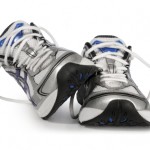I see many health care providers in my practice, including nurses, who work 8-12 hour shifts walking or standing on a hard surface that wreaks havoc on their feet as well as their knees hips and back. Heel pain, plantar fasciitis, shin splints, knee pain, hip pain, low back pain and many other aches and pains are quite common among this hard-working group.
One of the best ways to give your poor tired and sore body a little relief, is to make sure that you choose the best shoes you can to support you from the foundation up while at work.
For many people the choice of footwear is all too often based on factors such as how much they cost, how pretty they are or even which celebrity has endorsed them. Many will go straight to the bargain table and look for the least expensive shoe that fits them and off they go. Conversely, some will assume that the most expensive shoe in the store is the best shoe.
In determining how to choose a shoe to wear at work, your choice of shoes can make the difference between having a good or bad experience, working in comfort or pain, and, most importantly, whether you stay healthy or get injured. There really is no single 'best shoe' – as everyone has slightly different needs.
Choosing the right pair of shoes can be overwhelming given all the high-tech shoes available, the in-your-face marketing strategies employed by big shoe companies and all the bells and whistles that are described with every different shoe that you look at.
People often ask me what ‘Brand’ of shoe I recommend. There is no one best brand. If you recognize the brand name, then you are on the right track as all the big shoe companies have good products. You just have to make sure you find the product that is the best shoe for you. Most shoe companies divide their shoes into three main categories:
1) 1).cushioned
2). stability
3). motion control
These options are essentially categorized by your biomechanical needs.
Factors to Consider When Picking a Shoe:
●Biomechanics-Foot Type and Gait Type
●Weight
●Are you Injured or Have you Been Injured in the Past Year?
●The Fit of the Shoe
Biomechanics
Your feet are the foundation of the rest of your body and therefore they play an enormously important role in everything that happens above them.
The design of the foot is a fabulous thing. Leonardo Da Vinci (1452-1519) said it best: “The human foot is a masterpiece of engineering and a work of art”
The foot is designed to do two things every time you take a step. It first absorbs the shock of your body weight and then it has to form a rigid lever to push your body forward to the next step. It does this by using two important biomechanical motions:
Pronation (Rolling In): Pronation is normal and necessary for each step. It is the action of the foot rolling in such that it can absorb the weight of your body with each step.
Supination (Rolling Out): Supination is also normal and necessary for each step. It is the action of the foot rolling back out to line up the bones of the arch of the foot and form the rigid lever that helps you to move forward.
Biomechanical problems begin when a foot rolls in too much (over-pronation) or it rolls out too much (under-pronation). Most people that have aches and pains in their feet or legs will have feet that roll in too much or over-pronate.
One method of determining your level of foot pronation and, ultimately, foot and gait type is by checking your arch height. The easiest way to get a general idea of your arch is by using the 'Wet Test'. Look at the outline that your wet foot makes on the floor or the bath mat when you get out of the shower.
If you have a low arch (flat feet/over-pronator) you should choose Motion Control Shoes. If you have a normal arch (neutral pronation) you should choose Stability Shoes. If you have a high arch (under-pronator) you should choose Cushioned Shoes. (Keep in mind that high arch and under-pronation are extremely rare)
Most people assume that if their feet or knees are hurting, they should have more cushioning at their feet. This is actually the opposite of what they need. Most of the people have a foot that moves too much by rolling in too much (over-pronation). So instead of adding more cushioning, stabilizing the foot with a very supportive shoe will offer the relief that you are looking for.
Weight
The more you weigh, the more force you will generate each time you put your body weight over your foot, and consequently a heavier person needs a shoe that offers both cushioning for shock absorption and stability for added durability.
Are you Injured or Have you Been Injured in the Past Year?
If you are currently injured or have ongoing pain in your feet, legs, hips or back or if you have struggled with injury in the past year (and especially the last 3-6 months) then you will need more support at your feet until you can get past your injury and get healthy and strong again.
Shoe Fit
Despite what you have learned so far here, it is still a good idea to go to a specialty store to  purchase your new shoes. The people who work in these stores are knowledgeable and will guide you in making the best choice for your foot. If you have a particularly ‘special’ foot or if you have struggled finding the right shoe even with the advice of a specialty store, then consider seeing a health professional that has some expertise in this area. See a health care provider who has a lot of experience working with feet and offering advice in shoe selection.
purchase your new shoes. The people who work in these stores are knowledgeable and will guide you in making the best choice for your foot. If you have a particularly ‘special’ foot or if you have struggled finding the right shoe even with the advice of a specialty store, then consider seeing a health professional that has some expertise in this area. See a health care provider who has a lot of experience working with feet and offering advice in shoe selection.
When is it Time to Get New shoes?
Shoes should be changed every 500 miles or 800 km. For a health care professional working 40 hours per week on their feet, this equates to about a couple of times a year (every 6 months). Those who are heavier or who are struggling with pain or injury might need to change their shoes even more often (every 3 or 4 months).
When a patient presents to my office with a new symptom such as knee pain, shin splints, heel pain, hip or back pain one of the first things I ask about is the age and mileage of their shoes. Since shoes can appear to be in good condition but fail to provide adequate support, this is often a reason for a new injury.
For those with biomechanical challenges such as excessive pronation, severe bunions or a leg length discrepancy, a good shoe may not be enough and a custom orthotic insert may be recommended. Orthotics can help correct the biomechanics of muscles in the lower leg and foot to help stabilize the foot and restore normal function to both your feet and to all the structures above your feet. Talk to your health care provider about the best options for your feet.
Here’s to your happy feet!
 Dr. Peggy Malone is a Chiropractor and an Athlete who helps other athletes to overcome injury and get back to their sport. She also inspires patients from all walks of life to take control of their health to be as happy and as healthy as they can be.
Dr. Peggy Malone is a Chiropractor and an Athlete who helps other athletes to overcome injury and get back to their sport. She also inspires patients from all walks of life to take control of their health to be as happy and as healthy as they can be.
Her own athletic endeavors and injuries have given her valuable insight into working with athletes in her practice for both the care of injuries as well as for the improvement of athletic performance.
You can read more about her adventures and get some great information on health and wellness on her website.

Pingback: Tweets that mention Nurses Support Their Feet -- Topsy.com
I know wearing right feet is vital. I grew up with the "wrong" shoe size and mom bought because it was cheap and the price WAS right. I have only one living proof I live with without pain too being 1 bunion. Great informative post. When I used to run Nike was the shoe that best for me. Price was not a factor but comfort.
Pingback: Page not found